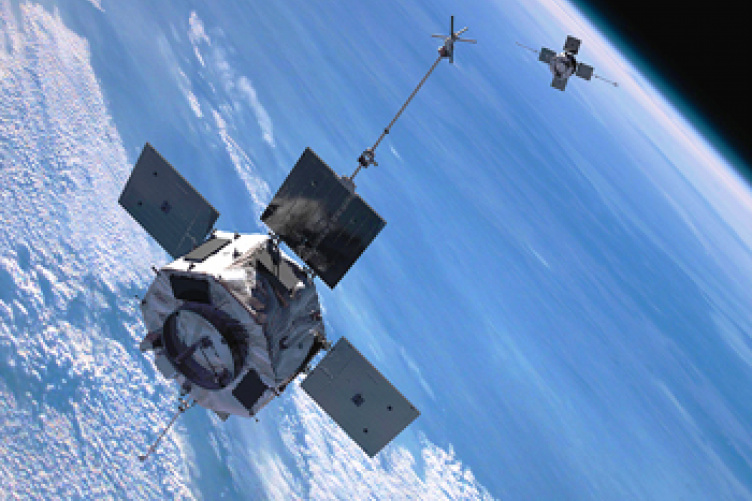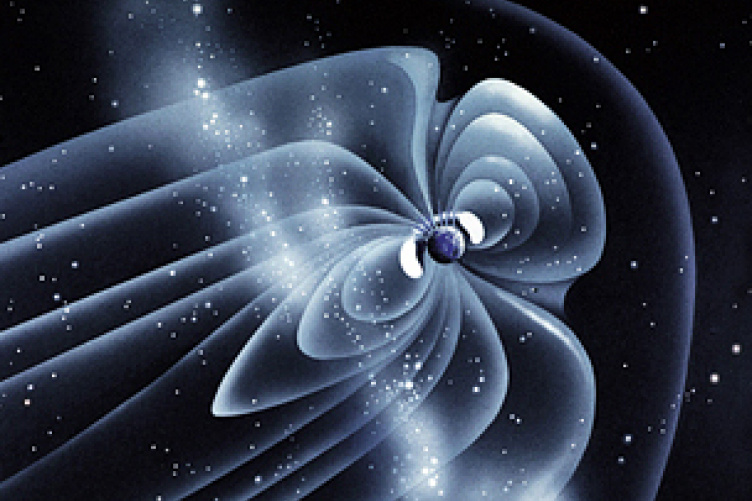Left - Artist's conception of the RBSP satellites. Image courtesy of Johns Hopkins University Applied Physics Laboratory
Right - Within the Earth's magnetosphere is a cavity of energetic particles trapped by the Earth's magnetic field—the Van Allen belts. Photo courtesy of NASA Marshall Space Flight Center.
Poised for Launch, NASA's Radiation Belt Storm Probes Have UNH All Over Them
At 4:07 a.m. Friday, August 24, after more than a dozen years from concept to creation, the twin Radiation Belt Storm Probes (RBSP) will rocket into the harsh environment of Earth's Van Allen radiation belts to probe their inner workings as never before. On board both spacecraft will be numerous scientific hardware and software components with a UNH Space Science Center (SSC) stamp on them.
"If you look at the instrument payload and factor in current and former Space Science Center people, UNH has a prominent role in RBSP," says Harlan Spence, EOS director and principal investigator for the Energetic Particle, Composition, and Thermal Plasma (ECT) instrument suite on board the twin spacecraft.
To wit, the ECT suite is comprised of three main instruments including one, the Magnetic Electron Ion Spectrometer, or MagEIS, which is replicated four times on each satellite. So at six sophisticated instruments per spacecraft, UNH leads a team providing more than half (12 of 20 instruments) of the scientific hardware for the historic mission. And eleven UNH team members of the ECT suite will be contributing to post-launch operations and science (see list at end of story).
Other instruments in the suite include the Helium Oxygen Proton Electron (HOPE) mass spectrometer and the Relativistic Electron Proton Telescope (REPT). The ECT instrument is a multi-institutional effort and involves the Los Alamos National Laboratory, Southwest Research Institute, The Aerospace Corporation, and the University of Colorado.
UNH scientists and engineers are also involved in the Electric and Magnetic Field Instrument Suite and Integrated Science (EMFISIS) experiment on board the RBSP spacecraft. Roy Torbert, SSC director, is a co-investigator for EMFISIS while former SSC research associate professor Craig Kletzing of the University of Iowa is principal investigator for the EMFISIS experiment.
It is fitting that Iowa is one of the four lead institutions for the mission; the university's James Van Allen discovered the belts in 1958 during the flight of the tiny Explorer 1 satellite that initiated U.S. space exploration.
The Van Allen belts are two donut-shaped regions of high-energy particles trapped by Earth's magnetic field. At the time of their discovery the radiation belts were thought to be relatively stable structures, but subsequent observations have shown they are dynamic and mysterious.
For example, sometimes after a solar storm the number of particles (protons and electrons) that populate the belts can increase dramatically and their speeds can approach the speed of light or become "relativistic"–about 186,000 miles per second. However, at other times after similar space weather events, the particles decrease in number and speed, or conditions seem to just stay the same.
Says Spence, "There can be a magnetic storm and the radiation belts will get pumped up, or nothing happens, or they'll disappear entirely. That's puzzling, and right now we don't understand enough to say why it's the case."
But physicists do know that what's going on is a kind of a tug of war, with various forces tugging one way to inflate the belts while others tug the other way deflating them. "But we don't know when and where those various forces can win out so we can't predict whether they'll go up, down, or stay the same," Spence notes.
So, in an effort to decipher the mysteries of this dangerous radiation environment, the unprecedented dual RBSP spacecraft will brave the storm and investigate the region for a minimum of two years. The twin satellites will chase each other in a common orbit to achieve simultaneous spatial and temporal measurements of the radiation belt environment. The two probes will measure the particles and the magnetic and electric fields and waves that fill this region of space surrounding Earth – "geospace."
"We know we can't study the particles in the absence of the electromagnetic fields that are causing them to change," says Spence. "In the past, there have been missions that have studied particles and missions that have studied wave phenomena and magnetic and electric fields. But until RBSP there has never been a comprehensive, coordinated investigation with two spacecraft simultaneously, and that's another big piece of the mission's story."
With a single spacecraft making measurements at a single point in space and time, there's no way of knowing what's happening "over there." But with twin satellites close together, says Spence, "you can actually see how things are evolving in space as they're evolving in time. Until we have that understanding we have no idea if the phenomenon we measure is something sweeping over the spacecraft or if it's just happening right at the spacecraft. Nailing this down will help us differentiate between current, competing theories."
Originally published by:
Spheres Online, Institute for the Study of Earth, Oceans, and Space



















































